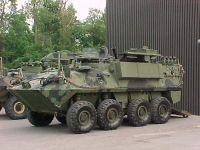- Reaction score
- 7,344
- Points
- 1,160
I wonder what an "M113 155mm Armored Personnel Carrier" is? I think we have a reporter mixing apples and oranges.
Not to be pedantic but I think you would be much better served by asymmetric regiments consisting of:
The key issue here is command and control both in training and for scalable operational deployments. Hybrid regiments with small numbers of varying capabilities are difficult to operate and develop a viable doctrine for.
- a 70/30 close support regiment with three 6-gun batteries, a small STA battery and a tactical battery providing enough FSCCs and FOOs and JTACs for at least one brigade. You bolster that with one 30/70 close support regiments for each formed RegF or ResF brigade (and I do not mean those ten things we call CBGs right now). (As between the CS regiments you create a mix of M777s and SPGs depending on defence missions and the CA structure)
- a 70/30 AD regiment bolstered by a 30/70 ResF AD regiment; and
- a 30/70 general support regiment with three HIMARS batteries, a loitering munition battery and an STA battery.
Troop and battery organizations are built around several factors: footprint of fire on the ground, local defence of the position, fire direction capabilities and logistics.
We are currently running two-gun troops in four-gun batteries. Conventional wisdom in the Cold War days with dumb ammunition was that you needed a three-gun 155mm fire unit to be effective at the target end which is why we had four-gun troops so that one gun could always be out of action for rest and maintenance. I'm not sure to what extent the old lore has been reviewed and revised. Our current structure is more based on equipment and PY numbers than anything else. I think its high time for a structure review and simply leave it at the fact that the US continues to run six-gun batteries divided into two firing platoons.
- The ability to have howitzers that can self locate mitigates on the footprint of fire on the ground factor as guns shooting form many different locations can now concentrate their fire much better than in the past.
- Similarly computer systems make fire direction much simpler (as long as you have a permissive EW environment) so that one command post can control a varying number of scattered elements.
- Local defence is probably a bigger issue now than in WW2 and Cold War days. Afghanistan made it clear that there would be no security detachments to attach to scattered gun positions and the troops had to look after themselves. A 30-man, two-gun troop is about the smallest that can take care of itself.
- Logistics become much more complicated the more scattered your gun batteries are.
We have ten provincial capitals and Ottawa which would indicate we need 44 saluting guns. For those guns, if used purely for saluting, barrel wear, sighting systems and recoil systems are essentially irrelevant. Wear and tear on wheel assemblies and trails and carriages becomes minimal. It should not be hard to winnow the fleet down to 44 saluting guns and spares.
The problem comes in only if we also need to use those same guns for training including live fire as we do now. They are long in the tooth and becoming harder and harder to keep functioning for live fire.
It's long past time where we should rearm the ResF (and the RegF) with enough of the right type of operational systems that the CA needs ... if the CA can ever figure out what it needs.

Suppose we were to look at static, or defensive forces, vs manoeuverist, or offensive forces?
While accepting that offensive action in the defence is necessary, and that every good defence, even a static one, needs a manoeuverist element, is it reasonable to suggest that an artillery unit that is tied to a particular location (a city that cannot be moved for example) may have a different structure than a unit that is designed to operate on the move?
For instance, if the guns can't be moved because of their tasking, then do they need GPS locating gear? Or are they better with engineers supplying overhead protection? What impact is there on the logistics if they can work from a deep magazine rather than a conveyor of trucks?
Do they need as many FDCs as unit on the move?
If the guns are not operating as constantly moving ones and twos can they survive being organized into large, emplaced, troops?
In other words, I guess, re-establishing a distinction amongst garrison, field and horse artillery with different kit and organizations particular to role?

